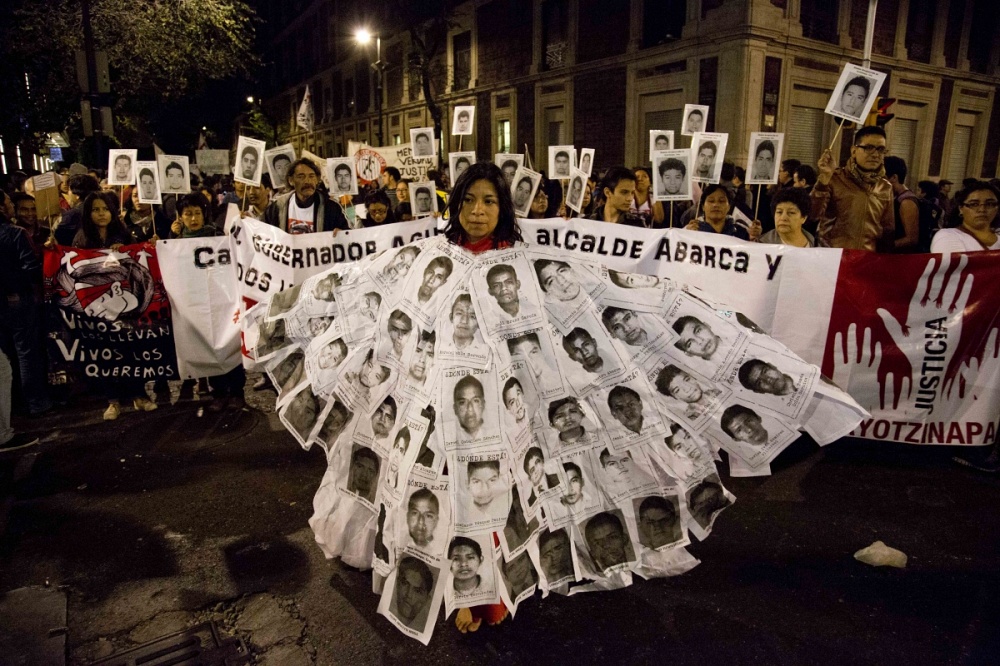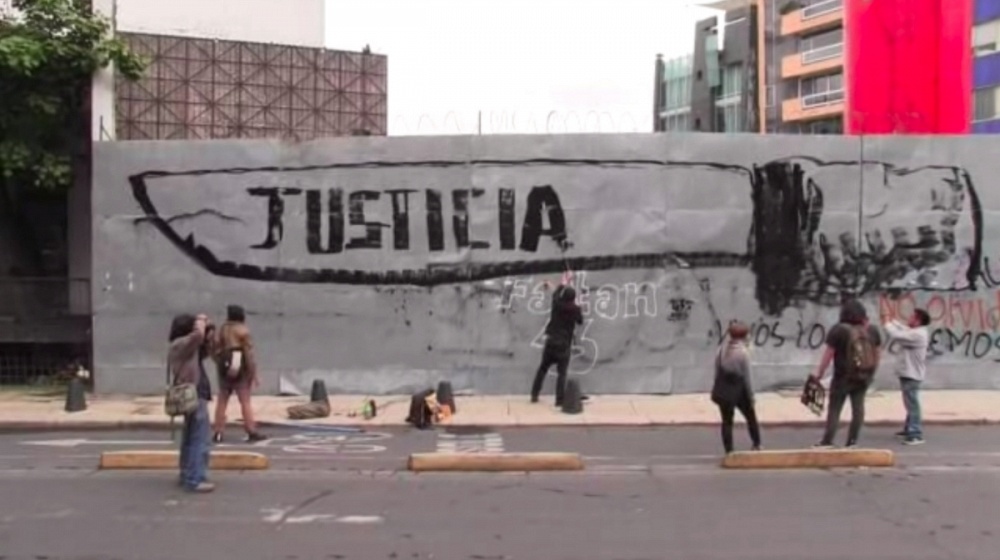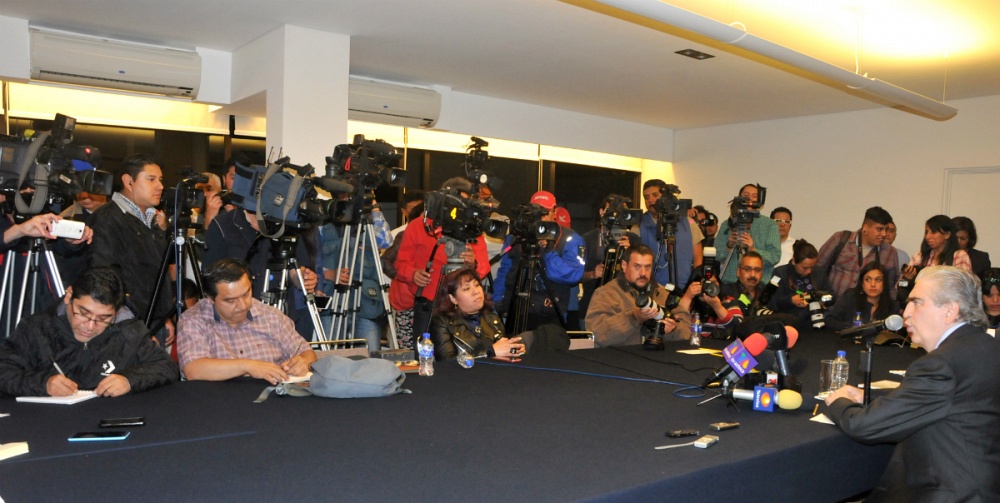Cancel the Counsel! Thoughts on, Trepidations about the Creation of Mexico’s Ministry of Culture
By
Gabriela Jauregui , Pablo Rojas
Here we are, once again, sitting in front of the computer debating heatedly whether or not to ask for government support for our books. We are part of a publishing collective called sur+ ediciones. When forty-three students from Ayotzinapa Normal School were forcibly disappeared by the state in 2014, we publicly declared we would not accept financial support from a murderous regime. Almost two years later, our small indie publishing venture is on the verge of collapse. Not for lack of moral support—our distributor and readers keep asking where the new books are—but rather because it is a hard-knock life, as many know, and attempting to be radically independent from the government’s many support grants is proving unviable in a country with an alarmingly tiny readership.1According to a 2007 UNESCO study on reading habits, Mexico occupies the 107th place (out of 108 countries). And, according to that same disconcerting study, the average Mexican reads 2.8 books a year. For more on this, see: http://www.letraslibres.com/revista/columnas/la-lectura-en-mexico1 (accessed 21 May 2016). So this morning we are debating where we are at. Or, rather, we are thinking about where the state’s cultural institutions are placed in relation to us and to the creative endeavors and individuals in this country more generally. This leads to ethical questions and more heated debate, including what we think about the new Ministry of Culture, which has come to replace CONACULTA (the National Counsel For Culture and Arts in Mexico), that also oversaw the FONCA (National Fund for Culture, where we would apply for a grant) and pretty much every single cultural institution in this country.
José Vasconcelos (1882–1959), visionary, madman, revolutionary, and proto-fascist creator of the national educational system in Mexico following the Revolution, once said, “culture engenders progress and without it we cannot demand any moral conduct from the people.” This is surely why culture and education were umbrellaed by one and the same ministry for almost a century, until some aptly paradoxical institutional revolutionary change happened: over twenty years ago, CONACULTA was formed.2Then and now the ruling political party was the PRI, considered a soft dictatorship, whose acronym stands for the oxymoronic Partido Revolucionario Institucional or Institutional Revolutionary Party. Back then it marked a new approach in terms of culture that was copied by many countries in Latin America—it was not a ministry of culture per se but an institution that functioned as a counsel, which should say everything about its founding spirit, in theory quite horizontal (vs. the verticality of a governmental ministry). One of the reasons it was created as a counsel, other than its purported horizontality, was that a ministry required many more legal procedures whereas CONACULTA could simply be created by presidential decree, as indeed it was under President Carlos Salinas de Gortari. After its creation, which grouped together other previously existing institutions, such as the INAH (National Anthropology and History Institute), INBA (National Fine Arts Institute), and IMCINE (Mexican Film Institute), CONACULTA constructed new institutions, like FONCA, and incorporated them into its cultural structure. And since it worked as a counsel, the positions of the directors of each institution were relatively equal, i.e., it would have been hard to put Radio Educación above the Cervantino Festival, or the Dirección General de Publicaciones, since they did not have any reason to compete with one another. That structure was studied by countries like Chile, which used CONACULTA as a model for the Chile National Arts Counsel.
Many other countries were also inspired by the Mexican model, especially in Central America. And some others created ministries instead, like Colombia, Brazil, and Argentina. “Nevertheless,” explains Raúl Zorrilla, who was a Mexican advisor for Chile when it created its own counsel, “they weren’t necessarily as effective as CONACULTA. I say this as an outsider now, and I know that one can criticize CONACULTA for many things but I dealt with many ministries, especially in Latin America, and CONACULTA did move forward while other countries, even though they had ministries, were so poor that they had very little impact.” Zorrilla, who now works in the private sector as the director of one of Mexico’s most prominent art galleries, worked in the public sector for many years, first as the director of EDUCAL (the national bookstore system and book distributor) in 1997, when he was still in his early twenties, until he returned to work in the diplomatic sector for eight years as president of the CERLALC (Regional Center for the Promotion of Books in Latin America and the Caribbean), an organization that is part of UNESCO and holds an honorary presidency, which administers all the book-related policies in Latin America, Spain, and Portugal. This, he explains, gave him experience of a more bilateral world.3In addition to his work with EDUCAL, Zorrilla was the director of the Dirección General de Publicaciones (the other book publisher, aside from the Fondo de Cultura Económica, which is in charge of book-related policies), secretary general of the FONCA, director of the FONCA, worked for the Mexican Cultural Institute in New York, and as a cultural officer for Latin America at the Inter-American Development Bank when he helped create its Cultural Foundation (which later became the office of cultural affairs). These are also the reasons we decided to speak to him. The justifications for contemporary writers, editors, artists, and so on to oppose the creation of a new cultural ministry seemed pretty obvious. But what about someone who knows about the good the bad and the ugly, from the inside?
The early twentieth-century vision, that culture is an educational vehicle within the state project and its nationalist construction, has been surpassed by the reality in which the field of cultural and artistic work cannot be perceived as exclusively educational in function. It obviously transcends this. And yet the intention for creating a cultural ministry in Mexico was not to rethink the idea of the ‘function’ of art and culture but rather to adjust or tailor it. A magnificent opportunity to redesign the state’s conception of culture has been lost, instead what is being proposed is to adapt its functionality. And so, as the old adage goes, one step forward means two steps back: cultural endeavors will no longer be linked to education but rather to efficiency, competency, and returns.
A clear example of this: for the past few years the Instituto Nacional de Bellas Artes (the National Institute of Fine Arts) started opting for grandiloquent exhibitions at the iconic museum of the Bellas Artes Palace, with blockbuster shows that say nothing about or rethink the country’s cultural policy (perhaps the most ludicrous and expensive ones were the Michelangelo and Leonardo da Vinci exhibitions. Although they included mostly very minor works, over 100,000 people visited on a single weekend).
If, until now, culture in Mexico has been perceived in relationship to its ‘function’ as education, it would seem that this role is being superseded by functionality: to attract investment, draw big audiences, and be spectacular. What is worse is that perhaps the only reference cultural bureaucrats have in order to determine whether a project is pertinent or not and to assign resources is called the Sistema de Evaluación del Desempeño (SED, “Performance Evaluation System”), which deals with verifying—in this order—the efficiency, efficacy, quality, results, impact, and sustainability of a project. The idea of assigning resources to ‘successful’ programs and no funding to programs that are ‘poorly designed’ or could fail should not necessarily be problematic, yet the issue is that the SED criteria are ambiguous at best. Especially when dealing with the arts. So, instead of rethinking cultural policy and its potential for change, this has become a novel savings policy: in the form of a government budget shaped on the incomplete and paradoxically termed “Base Zero” budget which was invented by American entrepreneurs in the 1960s. Take that Kant! Not only is schöne Kunst not autonomous, or, as he specifies his Critique of Judgement, “a mode of representation which is purposive for itself, and which, although devoid of a purpose, has the effect of advancing the culture of the mental powers in the interests of communications,” it has become pure neoliberal functionalism.
As per the declarations of Rafael Tovar y de Teresa, president of CONACULTA in the 1990s and now the once-again-yet-newly-instated minister of culture, there is nothing to speak of in terms of a redesign or a new vision in conceptual terms: “If you have a set of institutions and a budget, you’ll know who you give priority to and how to divide it and not leave it up to the almost individual negotiation there was until now.”4Rafael Tovar y de Teresa, in an interview with José Cárdenas, José Cárdenas Informa, 2 September 2015. He also had an apocryphally famous slip of the tongue in his minister’s inauguration speech when he said he would be honored to be the “minister of tourism.”
This new enormous ministry will include the gigantic Institute of Anthropology and History (INAH) and the Institute of Fine Arts (INBA), each of which oversees schools, museums, and research institutes, and TV Channel 22, which recently fired scores of employees in a scandalous ‘pro-government’ censorship move, IMCINE, which coordinates the National Film Production, the National Cinematheque, Radio Educación, the EDUCAL bookstore chain, the Cervantino Festival, and FONCA, this sort of philanthropic organism which provides resources and grants for cultural projects and which is, amongst many other things, the great co-publisher of many independent publishers in Mexico. This ministry is the body we are debating whether or not to ask for money from.
Historically Mexico has had a problematic and paternalistic relation between creators or cultural workers and state workers. Traditionally critical, the cultural community nevertheless lives in a perpetual tension between its independence and the resources the Mexican state grants them for their survival. It is a complicated relationship, which, if it does not impede upfront criticism, it does forego an in-depth discussion of the Mexican cultural panorama and does not support any attempt to put into practice successful non-government-related or independent cultural strategies.
So, another question our outside-insider Zorrilla brings up is that artists and cultural workers should ask themselves whether the fact that a public institution has strong impact is a good thing:
What is undeniable is that the institutions within CONACULTA were strong. Yet, after the creation of CONACULTA many legal issues arose. It was created somewhat hastily by presidential decree and it worked (as I mentioned many other countries copied its structure), but in legal terms it had many problems regarding its place within the hierarchy of Mexican bureaucracy. Simply put, even though they depend on CONACULTA, INBA and INAH for instance have a much more solid hierarchical structure since they were approved by congress and CONACULTA was never approved by congress. There began to be a need for an institution that would oversee all other existing cultural institutions, and this meant creating a Ministry of Culture with all the problems it entails, where you have many area directors who are apparently on a similar level but with a different administration (you can’t subordinate any of them to another) so there would be very few areas that actually overlap. The rest should remain on the same level despite the creation of a Ministry.5Zorrilla suggests that the Fondo de Cultura Económica and the Dirección General de Publicaciones (DGP) could really work as one, with EDUCAL as their sole book distributor. “DGP should promote reading and creating cultural policy, such as the ‘Ley del Libro’ (Single-price book law, which has also until now countered Amazon’s takeover of the market, for instance, and allowed for local publishers to remain competitive) and so the DGP should be pushing cultural policy regarding books and reading, not publishing books because the Fondo does that. There aren’t many other possible overlaps.”
The positive view should be that the ministry gives CONACULTA a legal framework to operate in, one it has been seeking for at least fifteen years. “It’s not something that the current administration just came up with,” continues Zorrilla, “it was a laborious process that began ten years ago. There’s been a trial and error process during the past three administrations. It didn’t happen overnight. Legislators were finally convinced of the need to do this, something which wasn’t the case ten years ago.” This places culture on the same level as the other activities that make up the president’s cabinet and so the minister can negotiate directly with the president:
For circumstantial reasons, in previous administrations, most CONACULTA presidents had direct personal access to the President.6And perhaps one might venture that this personal relation (rather than merit) was the reason for their appointment in the first place. But stricto sensu whatever happened in CONACULTA had to go through the Education Ministry, which is the largest Ministry in the country, made up of the largest syndicate in Latin America, and which has so many problems and issues that CONACULTA represented a tiny pea in the ocean of concerns of the Education Minister. So when CONACULTA was there, it was relegated to a very secondary plane. Now, the Culture Minister is part of the cabinet and discusses budget and important matters with the Presidency without having to go through the Education Ministry. It was a necessary step, you can’t live in illegality and it was impossible to give a legal framework for the current CONACULTA. The creation of the Ministry was approved unanimously, after many years of lobbying of course.
Like the proverbial return of the repressed, the PRI party returned to office after twelve years of so-called alternation. One of the things artists, writers, filmmakers, and so on find most disturbing is the return of Tovar y de Teresa. His return is no coincidence: he had been part of creating CONACULTA and knew how and why it was important for it to become a ministry. Yet, like most of us, Zorrilla also believes this is a mistake:
In this moment the culture in this country should be headed by a newer generation: culture is tremendously dynamic and there’s a strong disassociation between the Culture Ministry and what is contemporary, not just in visual arts but in all aspects of culture. Young creators feel it and resent it and they are alienated from cultural policy, no matter how many efforts are made, because there is no real contact between these cultural functionaries and what goes on today. When I was working there I was in contact with what was going on because I was a part of that generation. There should be a younger generation deciding the cultural future of this country. Mexico is culturally powerful in creative terms and it remains unclear what the State’s policies are towards fomenting that creativity. It’s not just about getting audiences to go see this or that show, but rather what are you doing as a State to foster that creativity.
And, clearly, it is not just about the state, as policies are also shaped by our needs, our concerns, our demands. We need to rethink our roles as citizens and artists: Are we working toward the people, toward the polis, toward the world? Are we protesting? Are we in context? Are we revealing autonomously that need to communicate Kant mentions? Is our activity quantifiable? Are we phantom legitimizers of a totalitarian regime? Are we courageous rats eating at the robes of Empire? Are we cynics? Are we radicals? Are we building those “frail architectures of collective happiness”?7Franco Berardi Bifo, “Emancipation of the Sign: Poetry and Finance During the Twentieth Century,” e-flux journal 39 (November 2012), [http://www.e-flux.com/journal/emancipation-of-the-sign-poetry-and-finance-during-the-twentieth-century/ (accessed 21 May 2016). Are we hungry? And for what?
We stare at the screen, the life of our little publishing house pulsing like the cursor. Click, we close the FONCA page, cancelling our application.


